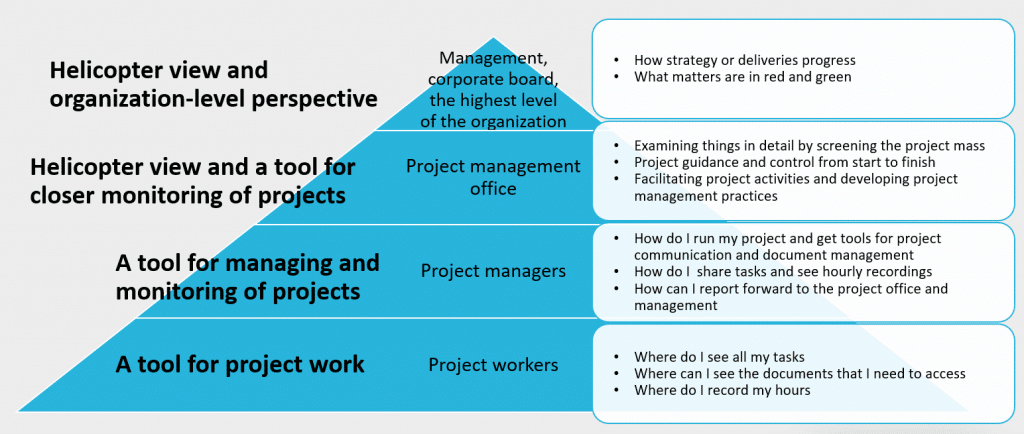In project management, unified operating methods and common rules create the basis for a blooming project culture and successful projects. With time and practical experience, a project culture built piece by piece creates the conditions for success.
Project culture typically serves an organization’s goals in the form of strategic development projects, so its role in the growth and development of a successful organization is central.
Organized project culture and project management in the form of integrated policies and tools play a particularly important role in the success of projects. This has been demonstrated by several hundred projects with our clients over the last ten years.
A successful project culture requires a systematic approach to an organization’s management structures and project management practices; what level of project management skills and management support for projects there is and how easy and effortless the tools and operating methods are.
Project management supported by the project manual
Project and portfolio management activities can be harmonized through common practices and rules that strengthen trust and cooperation between different stakeholders. More transparent project activities are also more comparable and thus easier to develop goals to be more supportive for all parties.
The project manual enables the implementation of practices and models that support the project culture. A handbook for the rules in project management begins to look like an organization’s own as the processes, roles, and tasks included in the project culture are defined and documented.
The project manual describes how things are done at the level of the entire organization and what procedures and tools are involved in project management. The role of the project manual is also to support the use of project management tools.
Both the project manual and the project management tool support the project management methodology, if one is used in the organization. The project manual, rules and practices, and tools are also worth thinking about from the perspective of how well they can serve all project workers.
Project pyramid levels with different needs and goals
The different levels of an organization in project management are well described by the project pyramid, each level having its own role, responsibilities, and needs. Considering the factor of these different levels plays an important role in the design and development of the project management system technically and culturally.

Directing strategic goals in the highest level, i.e. the organization’s management, requires a helicopter perspective and an organization-wide perspective on project work. To guide and manage the operation of the project portfolio, the project office needs a tool for more detailed monitoring of projects in addition to the helicopter perspective.
For project managers, a tool for project management, monitoring and reporting plays an important role in taking projects forward. Project team members at the lowest level of the pyramid need a tool to manage tasks, documents, and recording work hours, as well as other project work.
All the different levels of the pyramid are important in project management. The project manual and project management practices and tools help ensure that the goals of all project workers are met. The role of every project worker, regardless of the level of the pyramid, emphasizes the importance of correct and easy-to-use tools, information transparency and discoverability, and open communication.
Most of the needs and goals of the different levels of the project pyramid can be achieved through a knowledge center like Microsoft Teams. The creation of project groups in Teams can be automated with, for example, the Solu 365 tool.
The process of creating project groups is simplified, speeded up, and streamlined when a group with the right tools, such as predefined template documents, channel and file folder structures, and Planner task containers, can be set up with a few clicks.
Project culture is not built in a day
Building a project culture and project manual that serve the needs of your organization can be started using the project pyramid as a basis. Changing the culture in a more organized direction is a big job, and it is worth doing it slowly divided into smaller parts and stages.
The first step is to start lightly to get people excited about the change. When considering the methods used, the needs related to the project work of the organization is usually specified at this point. When people learn to do things according to new ways of working, it is often followed by a closer look at the projects and the stages required for their successful implementation.
In this way, the organization’s own project manual begins to take shape and the project culture grows and develops along with the manual. The project manual complements and clarifies the procedures included in the project culture for project management and successful implementation.
Indeed, project management focuses on the work people do, which should be supported by easy and effortless tools and practices. However, it is good to remember that creating and developing a project culture requires long-term and patient change management from a practical perspective and at the level of strategic objectives.
Contact us or book a project portfolio demo, and we will solve the challenges of project management together with your organization!
Jari Kyläjärvi
Director, Partner
Download the project management guide
Download our guide to smooth project management and make your organization's project work easier. Leave your contact information and we will send the guide to your email.








